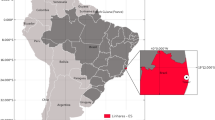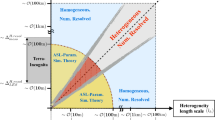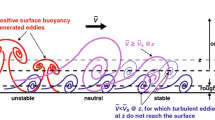Abstract
For the presentation and analysis of atmospheric boundary-layer (ABL) data, scales are used to non-dimensionalise the observed quantities and independent variables. Usually, the ABL height, surface sensible heat flux and surface scalar flux are used. This works well, so long as the absolute values of the entrainment ratio for both the scalar and temperature are similar. The entrainment ratio for temperature naturally ranges from −0.4 to −0.1. However, the entrainment ratio for passive scalars can vary widely in magnitude and sign. Then the entrainment flux becomes relevant as well. The only customary scalar scale that takes into account both the surface flux and the entrainment flux is the bulk scalar scale, but this scale is not well-behaved for large negative entrainment ratios and for an entrainment ratio equal to −1. We derive a new scalar scale, using previously published large-eddy simulation results for the convective ABL. The scale is derived under the constraint that scaled scalar variance profiles are similar at those heights where the variance producing mechanisms are identical (i.e., either near the entrainment layer or near the surface). The new scale takes into account that scalar variance in the ABL is not only related to the surface flux of that scalar, but to the scalar entrainment flux as well. Furthermore, it takes into account that the production of variance by the entrainment flux is an order of magnitude larger than the production of variance by the surface flux (per unit flux). Other desirable features of the new scale are that it is always positive (which is relevant when scaling standard deviations) and that the scaled variances are always of order 1–10.
Similar content being viewed by others
References
Betts A.K., Desjardins R.L., Macphersons J.I., and Kelly R.D. (1990). ‘Boundary-layer Heat and Moisture Budgets from FIFE’. Boundary-Layer Meteorol. 50:109–137
Cuijpers J.W.M. and Holtslag A.A.M. (1998). ‘Impact of Skewness and Nonlocal Effects on Scalar and Buoyncy Fluxes in Convective Boundary Layers’. J. Atmos. Sci. 55:151–162
de Arellano J.V.-G., Gioli B., Miglietta F., Jonker H.J.J., Baltink H.K., Hutjes R.W.A., and Holtslag A.A.M. (2004). ‘Entrainment Process of Carbon dioxide in the Atmospheric Boundary Layer’. J. Geophys. Res. 109:D18110
Deardorff J.W. (1970). ‘Convective Velocity and Temperature Scales for the Unstable Planetary Boundary Layer and Rayleigh. Convection’. J. Atmos. Sci. 27:1211–1213
Druilhet A., Frangi J.P., Guedalia D., and Fontan J. (1983). ‘Experimental Studies of the Turbulence Structure Parameters of the Convective Boundary Layer’. J. Climate Appl. Meteorol. 22:594–608
Garratt J.R. (1992). The Atmospheric Boundary Layer. Cambridge atmospheric and space science series, Cambridge University Press, U.K., 316pp.
Holtslag A.A.M., and Nieuwstadt F.T.M. (1986). ‘Scaling the Atmospheric Boundary Layer’. Boundary-Layer Meteorol. 36:201–209
Jonker H., de Arellano J.V.-G., and Duynkerke P. (2004). ‘Characteristic Length Scales of Reactive Species in a Convective Boundary Layer’. J. Atmos. Sci. 61:41–56
Mahrt L. (1991). ‘Boundary-layer Moisture Regimes’. Quart. J. Roy. Meteorol. Soc. 117:151–176
Michels B.I. and Jochum A.M. (1995). ‘Heat and Moisture Flux Profiles in a Region with Inhomogeneous Surface Evaporation’. J. Hydrol. 166:383–407
Moeng C.H. and Wyngaard J.C. (1984). ‘Statistics of Conservative Scalars in the Convective Boundary Layer’. J. Atmos. Sci. 41:3161–3169
Moeng C.H. and Wyngaard J.C. (1989). ‘Evaluation of Turbulent Transport and Dissipation Closures in Second-order Modeling’. J. Atmos. Sci. 46:2311–2330
Pino D., de Arellano J.V.-G., and Duynkerke P.G. (2003). ‘The Contribution of Shear to the Evolution of a Convective Boundary Layer’. J. Atmos. Sci. 60:1913–1926
Sorbjan Z. (1988). ‘Local Similarity in the Convective Boundary Layer’. Boundary-Layer Meteorol. 45:237–250
Sorbjan Z. (1990). ‘Similarity Scles and Universal Profiles of Statistical Moments in the Convective Boundary Layer’. J. Appl. Meteorol. 29:762–775
Sorbjan Z. (1991). ‘Evaluation of Local Similarity Functions in the Convective Boundary Layer’. J. Appl. Meteorol. 30:1565–1583
Sorbjan Z. (2004). ‘Large-eddy Simulations of the Baroclinic Mixed Layer’. Boundary-Layer Meteorol. 112:57–80
Sorbjan Z. (2005). ‘Statistics of Scalar Fields in the Atmospheric Boundary Layer Based on Large-eddy Simulations Part 1: Free Convection’. Boundary-Layer Meteorol 116:467–486
Stull R. (1988). An Introduction to Boundary Layer Meteorology. Kluwer Academic Publishers, Dordrecht, 666pp.
Wyngaard J. and Brost R.A. (1984). ‘Top-down and Bottom-up Diffusion of a Scalar in the Convective Boundary Layer’. J. Atmos. Sci 41:102–112
Author information
Authors and Affiliations
Corresponding author
Rights and permissions
About this article
Cite this article
Moene, A.F., Michels, B.I. & Holtslag, A.A.M. Scaling Variances of Scalars in a Convective Boundary Layer Under Different Entrainment Regimes. Boundary-Layer Meteorol 120, 257–274 (2006). https://doi.org/10.1007/s10546-006-9053-9
Received:
Published:
Issue Date:
DOI: https://doi.org/10.1007/s10546-006-9053-9




